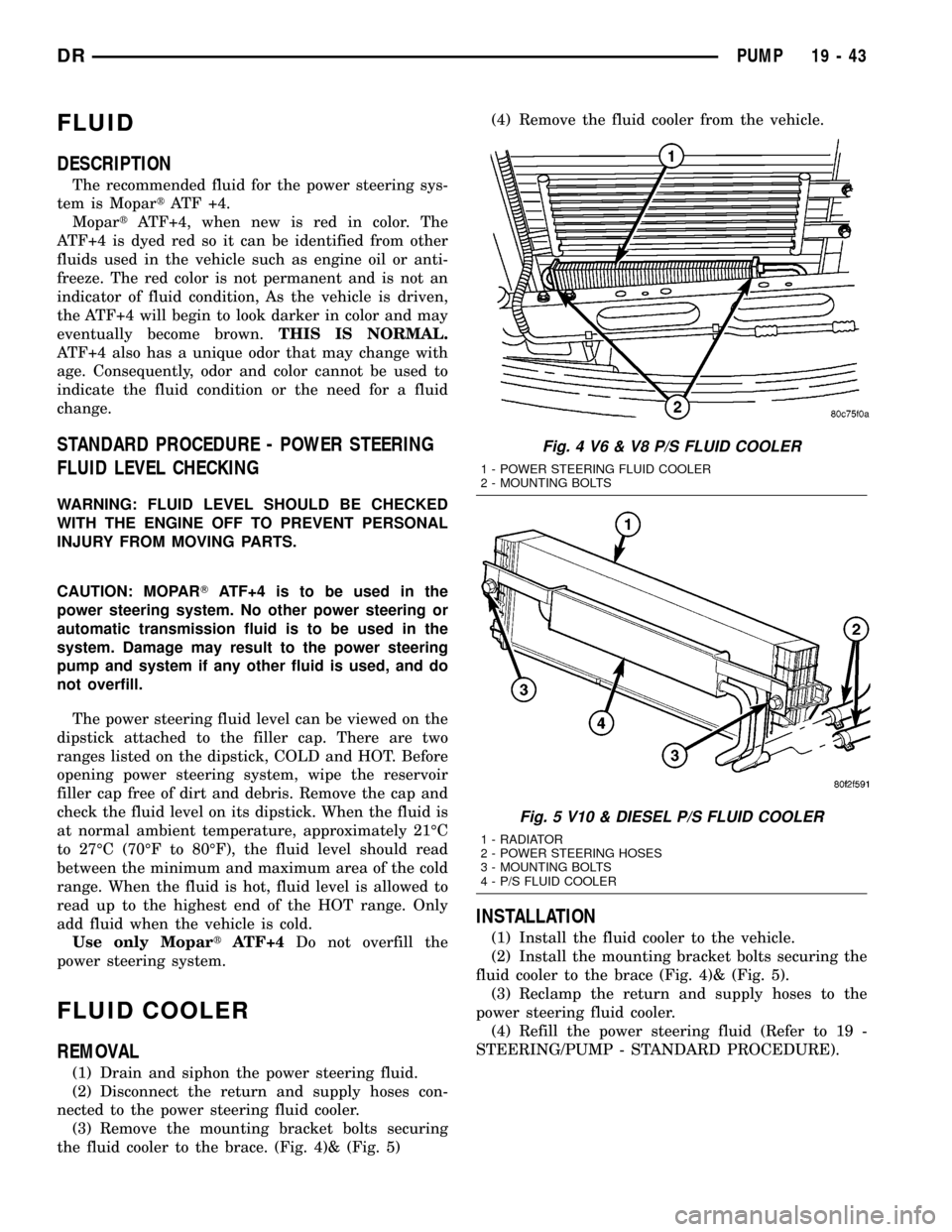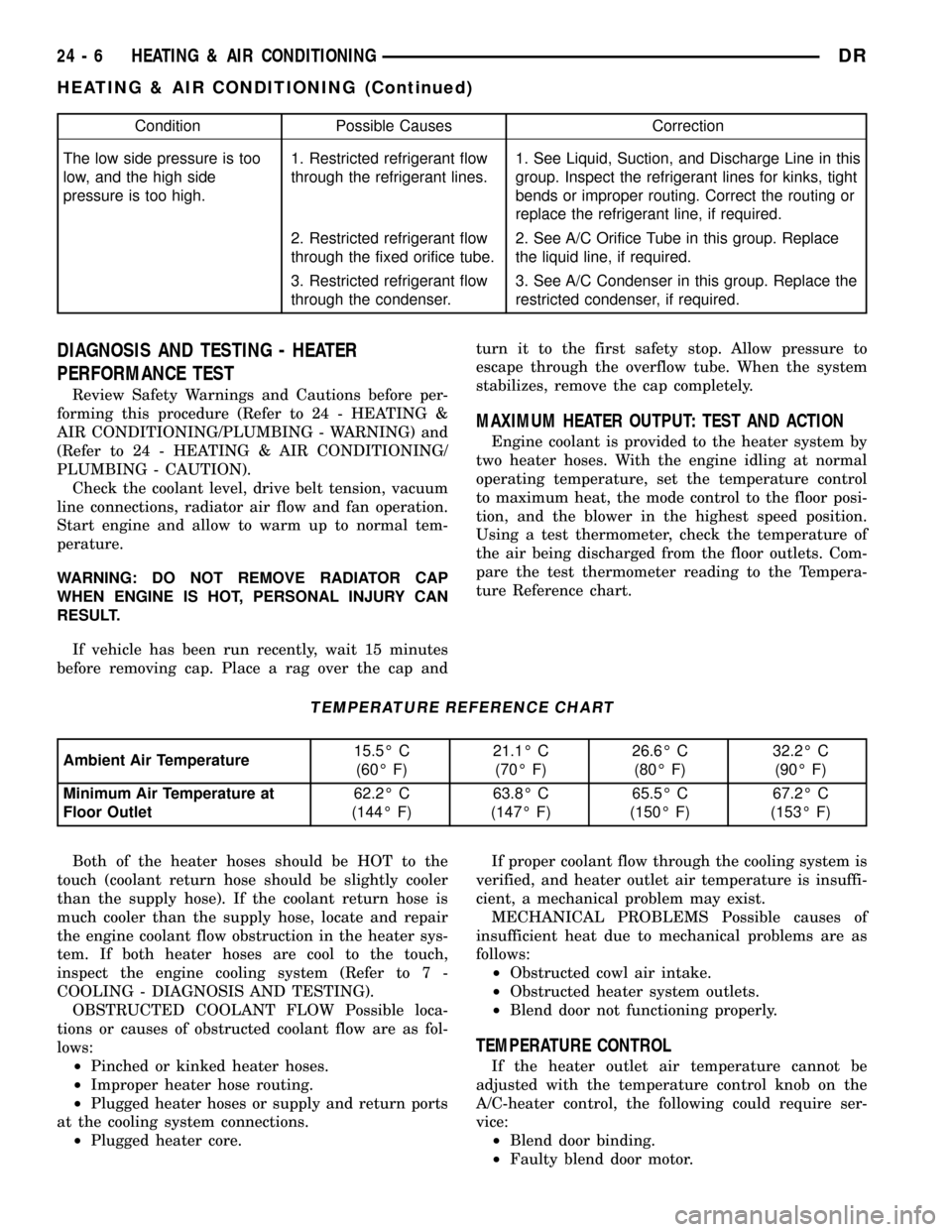1998 DODGE RAM 1500 radiator cap
[x] Cancel search: radiator capPage 1698 of 2627

FLUID
DESCRIPTION
The recommended fluid for the power steering sys-
tem is MopartATF +4.
MopartATF+4, when new is red in color. The
ATF+4 is dyed red so it can be identified from other
fluids used in the vehicle such as engine oil or anti-
freeze. The red color is not permanent and is not an
indicator of fluid condition, As the vehicle is driven,
the ATF+4 will begin to look darker in color and may
eventually become brown.THIS IS NORMAL.
ATF+4 also has a unique odor that may change with
age. Consequently, odor and color cannot be used to
indicate the fluid condition or the need for a fluid
change.
STANDARD PROCEDURE - POWER STEERING
FLUID LEVEL CHECKING
WARNING: FLUID LEVEL SHOULD BE CHECKED
WITH THE ENGINE OFF TO PREVENT PERSONAL
INJURY FROM MOVING PARTS.
CAUTION: MOPARTATF+4 is to be used in the
power steering system. No other power steering or
automatic transmission fluid is to be used in the
system. Damage may result to the power steering
pump and system if any other fluid is used, and do
not overfill.
The power steering fluid level can be viewed on the
dipstick attached to the filler cap. There are two
ranges listed on the dipstick, COLD and HOT. Before
opening power steering system, wipe the reservoir
filler cap free of dirt and debris. Remove the cap and
check the fluid level on its dipstick. When the fluid is
at normal ambient temperature, approximately 21ÉC
to 27ÉC (70ÉF to 80ÉF), the fluid level should read
between the minimum and maximum area of the cold
range. When the fluid is hot, fluid level is allowed to
read up to the highest end of the HOT range. Only
add fluid when the vehicle is cold.
Use only MopartATF+4Do not overfill the
power steering system.
FLUID COOLER
REMOVAL
(1) Drain and siphon the power steering fluid.
(2) Disconnect the return and supply hoses con-
nected to the power steering fluid cooler.
(3) Remove the mounting bracket bolts securing
the fluid cooler to the brace. (Fig. 4)& (Fig. 5)(4) Remove the fluid cooler from the vehicle.
INSTALLATION
(1) Install the fluid cooler to the vehicle.
(2) Install the mounting bracket bolts securing the
fluid cooler to the brace (Fig. 4)& (Fig. 5).
(3) Reclamp the return and supply hoses to the
power steering fluid cooler.
(4) Refill the power steering fluid (Refer to 19 -
STEERING/PUMP - STANDARD PROCEDURE).
Fig. 4 V6 & V8 P/S FLUID COOLER
1 - POWER STEERING FLUID COOLER
2 - MOUNTING BOLTS
Fig. 5 V10 & DIESEL P/S FLUID COOLER
1 - RADIATOR
2 - POWER STEERING HOSES
3 - MOUNTING BOLTS
4 - P/S FLUID COOLER
DRPUMP 19 - 43
Page 1905 of 2627

(2) Heavy duty operation with a vehicle not prop-
erly equipped for this type of operation. Trailer tow-
ing or similar high load operation will overheat the
transmission fluid if the vehicle is improperly
equipped. Such vehicles should have an auxiliary
transmission fluid cooler, a heavy duty cooling sys-
tem, and the engine/axle ratio combination needed to
handle heavy loads.
DIAGNOSIS AND TESTING - FLUID
CONTAMINATION
Transmission fluid contamination is generally a
result of:
²adding incorrect fluid
²failure to clean dipstick and fill tube when
checking level
²engine coolant entering the fluid
²internal failure that generates debris
²overheat that generates sludge (fluid break-
down)
²failure to replace contaminated converter after
repair
The use of non-recommended fluids can result in
transmission failure. The usual results are erratic
shifts, slippage, abnormal wear and eventual failure
due to fluid breakdown and sludge formation. Avoid
this condition by using recommended fluids only.
The dipstick cap and fill tube should be wiped
clean before checking fluid level. Dirt, grease and
other foreign material on the cap and tube could fall
into the tube if not removed beforehand. Take the
time to wipe the cap and tube clean before withdraw-
ing the dipstick.
Engine coolant in the transmission fluid is gener-
ally caused by a cooler malfunction. The only remedy
is to replace the radiator as the cooler in the radiator
is not a serviceable part. If coolant has circulated
through the transmission, an overhaul is necessary.
The torque converter should also be replaced when-
ever a failure generates sludge and debris. This is
necessary because normal converter flushing proce-
dures will not remove all contaminants.
STANDARD PROCEDURE
STANDARD PROCEDURE - FLUID LEVEL
CHECK
Low fluid level can cause a variety of conditions
because it allows the pump to take in air along with
the fluid. As in any hydraulic system, air bubbles
make the fluid spongy, therefore, pressures will be
low and build up slowly.
Improper filling can also raise the fluid level too
high. When the transmssion has too much fluid, thegeartrain churns up foam and cause the same condi-
tions which occur with a low fluid level.
In either case, air bubbles can cause overheating
and/or fluid oxidation, and varnishing. This can
interfere with normal valve, clutch, and accumulator
operation. Foaming can also result in fluid escaping
from the transmission vent where it may be mis-
taken for a leak.
After the fluid has been checked, seat the dipstick
fully to seal out water and dirt.
The transmission has a dipstick to check oil level.
It is located on the right side of the engine. Be sure
to wipe all dirt from dipstick handle before removing.
Fluid level is checked with the engine running at
curb idle speed, the transmission in NEUTRAL and
the transmission fluid at normal operating tempera-
ture.The engine should be running at idle
speed for at least one minute, with the vehicle
on level ground.
The transmission fluid level can be checked two
ways.
PROCEDURE ONE
(1) Transmission fluid must be at normal operat-
ing temperature for accurate fluid level check. Drive
vehicle if necessary to bring fluid temperature up to
normal hot operating temperature of 82ÉC (180ÉF).
(2) Position vehicle on level surface.
(3) Start and run engine at curb idle speed.
(4) Apply parking brakes.
(5) Shift transmission momentarily into all gear
ranges. Then shift transmission back to NEUTRAL.
(6) Clean top of filler tube and dipstick to keep
dirt from entering tube.
(7) Remove dipstick (Fig. 87) and check fluid level
as follows:
(a) Correct acceptable level is in crosshatch area.
(b) Correct maximum level is to MAX arrow
mark.
(c) Incorrect level is at or below MIN line.
(d) If fluid is low, add only enough MopartAT F
+4 to restore correct level. Do not overfill.
Fig. 87 Dipstick Fluid Level Marks - Typical
1 - DIPSTICK
2 - MAXIMUM CORRECT FLUID LEVEL
3 - ACCEPTABLE FLUID LEVEL
21 - 202 AUTOMATIC TRANSMISSION - 48REDR
FLUID AND FILTER (Continued)
Page 2069 of 2627

FLUID AND FILTER
DIAGNOSIS AND TESTING
DIAGNOSIS AND TESTING - EFFECTS OF
INCORRECT FLUID LEVEL
A low fluid level allows the pump to take in air
along with the fluid. Air in the fluid will cause fluid
pressures to be low and develop slower than normal.
If the transmission is overfilled, the gears churn the
fluid into foam. This aerates the fluid and causing
the same conditions occurring with a low level. In
either case, air bubbles cause fluid overheating, oxi-
dation and varnish buildup which interferes with
valve and clutch operation. Foaming also causes fluid
expansion which can result in fluid overflow from the
transmission vent or fill tube. Fluid overflow can eas-
ily be mistaken for a leak if inspection is not careful.
DIAGNOSIS AND TESTING - CAUSES OF
BURNT FLUID
Burnt, discolored fluid is a result of overheating
which has three primary causes.
(1) Internal clutch slippage, usually caused by low
line pressure, inadequate clutch apply pressure, or
clutch seal failure.
(2) A result of restricted fluid flow through the
main and/or auxiliary cooler. This condition is usu-
ally the result of a faulty or improperly installed
drainback valve, a damaged main cooler, or severe
restrictions in the coolers and lines caused by debris
or kinked lines.
(3) Heavy duty operation with a vehicle not prop-
erly equipped for this type of operation. Trailer tow-
ing or similar high load operation will overheat the
transmission fluid if the vehicle is improperly
equipped. Such vehicles should have an auxiliary
transmission fluid cooler, a heavy duty cooling sys-
tem, and the engine/axle ratio combination needed to
handle heavy loads.
DIAGNOSIS AND TESTING - FLUID
CONTAMINATION
Transmission fluid contamination is generally a
result of:
²adding incorrect fluid
²failure to clean dipstick and fill tube when
checking level
²engine coolant entering the fluid
²internal failure that generates debris
²overheat that generates sludge (fluid break-
down)
²failure to replace contaminated converter after
repairThe use of non-recommended fluids can result in
transmission failure. The usual results are erratic
shifts, slippage, abnormal wear and eventual failure
due to fluid breakdown and sludge formation. Avoid
this condition by using recommended fluids only.
The dipstick cap and fill tube should be wiped
clean before checking fluid level. Dirt, grease and
other foreign material on the cap and tube could fall
into the tube if not removed beforehand. Take the
time to wipe the cap and tube clean before withdraw-
ing the dipstick.
Engine coolant in the transmission fluid is gener-
ally caused by a cooler malfunction. The only remedy
is to replace the radiator as the cooler in the radiator
is not a serviceable part. If coolant has circulated
through the transmission, an overhaul is necessary.
The torque converter should also be replaced when-
ever a failure generates sludge and debris. This is
necessary because normal converter flushing proce-
dures will not remove all contaminants.
STANDARD PROCEDURE
STANDARD PROCEDURE - FLUID LEVEL
CHECK
Low fluid level can cause a variety of conditions
because it allows the pump to take in air along with
the fluid. As in any hydraulic system, air bubbles
make the fluid spongy, therefore, pressures will be
low and build up slowly.
Improper filling can also raise the fluid level too
high. When the transmssion has too much fluid, the
geartrain churns up foam and cause the same condi-
tions which occur with a low fluid level.
In either case, air bubbles can cause overheating
and/or fluid oxidation, and varnishing. This can
interfere with normal valve, clutch, and accumulator
operation. Foaming can also result in fluid escaping
from the transmission vent where it may be mis-
taken for a leak.
After the fluid has been checked, seat the dipstick
fully to seal out water and dirt.
The transmission has a dipstick to check oil level.
It is located on the right side of the engine. Be sure
to wipe all dirt from dipstick handle before removing.
The torque converter fills in both the P (PARK)
and N (NEUTRAL) positions. Place the selector lever
in P (PARK) to be sure that the fluid level check is
accurate.The engine should be running at idle
speed for at least one minute, with the vehicle
on level ground.At normal operating temperature
(approximately 82 C. or 180 F.), the fluid level is cor-
rect if it is in the HOT region (cross-hatched area) on
the oil level indicator. The fluid level will be approx-
21 - 366 AUTOMATIC TRANSMISSION - 45RFE/545RFEDR
Page 2488 of 2627

HEATING & AIR CONDITIONING
TABLE OF CONTENTS
page page
HEATING & AIR CONDITIONING
DESCRIPTION
DESCRIPTION - ENGINE COOLING
SYSTEM REQUIREMENTS...............1
DESCRIPTION - HEATER AND AIR
CONDITIONER........................1
OPERATION - HEATER AND AIR
CONDITIONER........................1
DIAGNOSIS AND TESTING
DIAGNOSIS AND TESTING - A/C
PERFORMANCE.......................3DIAGNOSIS AND TESTING - HEATER
PERFORMANCE TEST..................6
SPECIFICATIONS - A/C SYSTEM............7
CONTROLS.............................9
DISTRIBUTION..........................26
PLUMBING.............................41
HEATING & AIR
CONDITIONING
DESCRIPTION
DESCRIPTION - ENGINE COOLING SYSTEM
REQUIREMENTS
To maintain the performance level of the heating,
ventilation and air conditioning (HVAC) system, the
engine cooling system must be properly maintained.
The use of a bug screen is not recommended. Any
obstructions in front of the radiator or A/C condenser
will reduce the performance of the A/C and engine
cooling systems.
The engine cooling system includes the radiator,
thermostat, radiator hoses and the engine coolant
pump. Refer to Cooling for more information before
opening or attempting any service to the engine cool-
ing system.
DESCRIPTION - HEATER AND AIR
CONDITIONER
A manually controlled single zone type heating-air
conditioning system or a manually controlled dual
zone type heating-air conditioning system is available
on this model.
All vehicles are equipped with a common heater,
ventilation and air conditioning (HVAC) housing (Fig.
1). The system combines air conditioning, heating,
and ventilating capabilities in a single unit housing
mounted within the passenger compartment under
the instrument panel. The HVAC housing includes:
²Blower motor
²Blower motor resistor block²Heater core
²Evaporator coil
²Blend door and actuator
²Defrost door and actuator
²Mode door and actuator
²Recirculation door and actuator
Based upon the system and mode selected, condi-
tioned air can exit the HVAC housing through one or
a combination of the three main housing outlets:
defrost, panel or floor. The defrost outlet is located on
the top of the housing, the panel outlet is located on
the face of the housing and the floor outlet is located
on the bottom of the housing. Once the conditioned
air exits the unit housing, it is further directed
through molded plastic ducts to the various outlets in
the vehicle interior. These outlets and their locations
are as follows:
²Defroster Outlet- A single large defroster out-
let is located in the center of the instrument panel
top cover, near the base of the windshield.
²Side Window Demister Outlets- There are
two side window demister outlets, one is located at
each outboard end of the instrument panel top cover,
near the belt line at the A-pillars.
²Panel Outlets- There are four panel outlets in
the instrument panel, one located near each outboard
end of the instrument panel facing the rear of the
vehicle and two located near the top of the instru-
ment panel center bezel.
²Front Floor Outlets- There are two front floor
outlets, one located above each side of the floor panel
center tunnel near the dash panel.
OPERATION - HEATER AND AIR CONDITIONER
The heating and air conditioning systems pulls
outside (ambient) air through the cowl opening at the
base of the windshield, then into the plenum cham-
DRHEATING & AIR CONDITIONING 24 - 1
Page 2493 of 2627

Condition Possible Causes Correction
The low side pressure is too
low, and the high side
pressure is too high.1. Restricted refrigerant flow
through the refrigerant lines.1. See Liquid, Suction, and Discharge Line in this
group. Inspect the refrigerant lines for kinks, tight
bends or improper routing. Correct the routing or
replace the refrigerant line, if required.
2. Restricted refrigerant flow
through the fixed orifice tube.2. See A/C Orifice Tube in this group. Replace
the liquid line, if required.
3. Restricted refrigerant flow
through the condenser.3. See A/C Condenser in this group. Replace the
restricted condenser, if required.
DIAGNOSIS AND TESTING - HEATER
PERFORMANCE TEST
Review Safety Warnings and Cautions before per-
forming this procedure (Refer to 24 - HEATING &
AIR CONDITIONING/PLUMBING - WARNING) and
(Refer to 24 - HEATING & AIR CONDITIONING/
PLUMBING - CAUTION).
Check the coolant level, drive belt tension, vacuum
line connections, radiator air flow and fan operation.
Start engine and allow to warm up to normal tem-
perature.
WARNING: DO NOT REMOVE RADIATOR CAP
WHEN ENGINE IS HOT, PERSONAL INJURY CAN
RESULT.
If vehicle has been run recently, wait 15 minutes
before removing cap. Place a rag over the cap andturn it to the first safety stop. Allow pressure to
escape through the overflow tube. When the system
stabilizes, remove the cap completely.
MAXIMUM HEATER OUTPUT: TEST AND ACTION
Engine coolant is provided to the heater system by
two heater hoses. With the engine idling at normal
operating temperature, set the temperature control
to maximum heat, the mode control to the floor posi-
tion, and the blower in the highest speed position.
Using a test thermometer, check the temperature of
the air being discharged from the floor outlets. Com-
pare the test thermometer reading to the Tempera-
ture Reference chart.
TEMPERATURE REFERENCE CHART
Ambient Air Temperature15.5É C
(60É F)21.1É C
(70É F)26.6É C
(80É F)32.2É C
(90É F)
Minimum Air Temperature at
Floor Outlet62.2É C
(144É F)63.8É C
(147É F)65.5É C
(150É F)67.2É C
(153É F)
Both of the heater hoses should be HOT to the
touch (coolant return hose should be slightly cooler
than the supply hose). If the coolant return hose is
much cooler than the supply hose, locate and repair
the engine coolant flow obstruction in the heater sys-
tem. If both heater hoses are cool to the touch,
inspect the engine cooling system (Refer to 7 -
COOLING - DIAGNOSIS AND TESTING).
OBSTRUCTED COOLANT FLOW Possible loca-
tions or causes of obstructed coolant flow are as fol-
lows:
²Pinched or kinked heater hoses.
²Improper heater hose routing.
²Plugged heater hoses or supply and return ports
at the cooling system connections.
²Plugged heater core.If proper coolant flow through the cooling system is
verified, and heater outlet air temperature is insuffi-
cient, a mechanical problem may exist.
MECHANICAL PROBLEMS Possible causes of
insufficient heat due to mechanical problems are as
follows:
²Obstructed cowl air intake.
²Obstructed heater system outlets.
²Blend door not functioning properly.
TEMPERATURE CONTROL
If the heater outlet air temperature cannot be
adjusted with the temperature control knob on the
A/C-heater control, the following could require ser-
vice:
²Blend door binding.
²Faulty blend door motor.
24 - 6 HEATING & AIR CONDITIONINGDR
HEATING & AIR CONDITIONING (Continued)
Page 2529 of 2627

REFRIGERANT OIL
DESCRIPTION.........................68
OPERATION...........................69
STANDARD PROCEDURE - REFRIGERANT
OIL LEVEL...........................69
SERVICE PORT VALVE CORE
DESCRIPTION.........................70
REMOVAL - SERVICE PORT VALVE CORES . . 70
INSTALLATION.........................70
SUCTION LINE
DESCRIPTION.........................70REMOVAL
REMOVAL - 5.9L DIESEL ENGINE.........70
REMOVAL - 3.7L/4.7L AND 5.7L HEMI
ENGINE.............................71
INSTALLATION
INSTALLATION - 5.9L DIESEL ENGINE.....72
INSTALLATION - 3.7L/4.7L AND 5.7L HEMI
ENGINE.............................73
PLUMBING
DESCRIPTION - REFRIGERANT LINE
The refrigerant lines and hoses are used to carry
the refrigerant between the various air conditioning
system components. A barrier hose design with a
nylon tube, which is sandwiched between rubber lay-
ers, is used for the R-134a air conditioning system on
this vehicle. This nylon tube helps to further contain
the R-134a refrigerant, which has a smaller molecu-
lar structure than R-12 refrigerant. The ends of the
refrigerant hoses are made from lightweight alumi-
num or steel, and commonly use braze-less fittings.
Any kinks or sharp bends in the refrigerant plumb-
ing will reduce the capacity of the entire air condi-
tioning system. Kinks and sharp bends reduce the
flow of refrigerant in the system. A good rule for the
flexible hose refrigerant lines is to keep the radius of
all bends at least ten times the diameter of the hose.
In addition, the flexible hose refrigerant lines should
be routed so they are at least 80 millimeters (3
inches) from an exhaust manifold.
OPERATION- REFRIGERANT LINES
High pressures are produced in the refrigerant sys-
tem when the air conditioning compressor is operat-
ing. Extreme care must be exercised to make sure
that each of the refrigerant system connections is
pressure-tight and leak free. It is a good practice to
inspect all flexible hose refrigerant lines at least once
a year to make sure they are in good condition and
properly routed.
The refrigerant lines and hoses are coupled with
other components of the HVAC system with either
O-rings or dual plane seals.
The refrigerant lines and hoses cannot be repaired
and, if faulty or damaged, they must be replaced.
WARNING
ENGINE COOLING SYSTEM
WARNING: THE ENGINE COOLING SYSTEM IS
DESIGNED TO DEVELOP INTERNAL PRESSURES
OF 97 TO 123 KILOPASCALS (14 TO 18 POUNDS
PER SQUARE INCH). DO NOT REMOVE OR
LOOSEN THE COOLANT PRESSURE CAP, CYLIN-
DER BLOCK DRAIN PLUGS, RADIATOR DRAIN,
RADIATOR HOSES, HEATER HOSES, OR HOSE
CLAMPS WHILE THE ENGINE COOLING SYSTEM IS
HOT AND UNDER PRESSURE. FAILURE TO
OBSERVE THIS WARNING CAN RESULT IN SERI-
OUS BURNS FROM THE HEATED ENGINE COOL-
ANT. ALLOW THE VEHICLE TO COOL FOR A
MINIMUM OF 15 MINUTES BEFORE OPENING THE
COOLING SYSTEM FOR SERVICE.
24 - 42 PLUMBINGDR
Page 2592 of 2627

BURNT FLUID - DIAGNOSIS AND
TESTING, CAUSES OF..........21-201,21-366
BUSHING - INSTALLATION.............19-19
BUSHING - INSTALLATION, TORSION
BAR CROSS MEMBER..................2-15
BUSHING - REMOVAL.................19-19
BUSHING - REMOVAL, TORSION BAR
CROSSMEMBER......................2-13
BUSHING AND SEAL - INSTALLATION,
EXTENSION HOUSING................21-440
BUSHING AND SEAL - REMOVAL,
EXTENSION HOUSING................21-440
BUSHINGS - 2WD (LD) - INSTALLATION,
LOWER CONTROL ARM................2-15
BUSHINGS - 2WD (LD) - REMOVAL,
LOWER CONTROL ARM................2-13
BUSHINGS - 4WD (LD) - INSTALLATION,
LOWER CONTROL ARM................2-14
BUSHINGS - 4WD (LD) - REMOVAL,
LOWER CONTROL ARM................2-13
BUSHINGS - INSTALLATION.............2-43
BUSHINGS - REMOVAL.................2-43
BUZZ, SQUEAK & RATTLE - STANDARD
PROCEDURE........................23-11
BYPASS - DESCRIPTION, WATER PUMP . . . 7-59
BYPASS - OPERATION, WATER PUMP.....7-60
C205F - ADJUSTMENTS, FRONT AXLE.....3-32
C205F - DIAGNOSIS AND TESTING,
FRONT AXLE.........................3-27
C205F - INSTALLATION, FRONT AXLE.....3-31
C205F - REMOVAL, FRONT AXLE...........3-31
C205F - SPECIAL TOOLS, FRONT AXLE....3-40
C205F - SPECIFICATIONS, FRONT AXLE....3-39
CAB - INSTALLATION, QUAD......8O-36,8O-61
CAB - INSTALLATION, STANDARD . . 8O-35,8O-61
CAB - REMOVAL, QUAD..........8O-33,8O-60
CAB - REMOVAL, STANDARD......8O-32,8O-59
CAB BACK PANEL TRIM -
INSTALLATION, REAR.................23-69
CAB BACK PANEL TRIM - REMOVAL,
REAR..............................23-68
CAB CLEARANCE LAMP - INSTALLATION . . 8L-12
CAB CLEARANCE LAMP - REMOVAL.....8L-11
CABLE - ADJUSTMENTS, THROTTLE
VALVE ............................21-254
CABLE - DESCRIPTION.................8P-4
CABLE - DESCRIPTION, ANTENNA BODY . . . 8A-4
CABLE - DESCRIPTION, SPARK PLUG.....8I-21
CABLE - DESCRIPTION, THROTTLE
VALVE ............................21-253
CABLE - DIAGNOSIS AND TESTING,
ANTENNA BODY......................8A-4
CABLE - DIAGNOSIS AND TESTING,
GEARSHIFT..................21-210,21-368
CABLE - INSTALLATION................8P-5
CABLE - INSTALLATION, ANTENNA BODY . . 8A-6
CABLE - INSTALLATION, CHECK.........23-15
CABLE - INSTALLATION, FRONT
PARKING BRAKE......................5-38
CABLE - INSTALLATION, GEARSHIFT....21-211,
21-370
CABLE - INSTALLATION, INSTRUMENT
PANEL ANTENNA......................8A-7
CABLE - INSTALLATION, LEFT REAR......5-39
CABLE - INSTALLATION, REAR PARK
BRAKE..............................5-38
CABLE - INSTALLATION, RIGHT REAR.....5-38
CABLE - INSTALLATION, SPARK PLUG....8I-22
CABLE - INSTALLATION, THROTTLE
CONTROL.....................14-40,14-84
CABLE - OPERATION...................8P-4
CABLE - OPERATION, ANTENNA BODY
.....8A-4
CABLE - OPERATION, SPARK PLUG
.......8I-21
CABLE - REMOVAL
....................8P-4
CABLE - REMOVAL, ANTENNA BODY
......8A-6
CABLE - REMOVAL, CHECK
.............23-15
CABLE - REMOVAL, FRONT PARKING
BRAKE
..............................5-36
CABLE - REMOVAL, GEARSHIFT
. . 21-210,21-369
CABLE - REMOVAL, INSTRUMENT PANEL
ANTENNA
...........................8A-7
CABLE - REMOVAL, LEFT REAR
..........5-38
CABLE - REMOVAL, REAR PARK BRAKE
. . . 5-37
CABLE - REMOVAL, RIGHT REAR
.........5-37
CABLE - REMOVAL, SPARK PLUG
........8I-22
CABLE - REMOVAL, THROTTLE
CONTROL
.....................14-38,14-83CABLE, ADJUSTMENTS - GEARSHIFT . . . 21-212,
21-370
CABLE RESISTANCE, SPECIFICATIONS -
SPARK PLUG.........................8I-4
CABLE ROUTING, 5.7L V-8 ENGINE -
FIRING ORDER........................8I-4
CABLE/HANDLE ASSEMBLY -
INSTALLATION, LATCH RELEASE........23-47
CABLE/HANDLE ASSEMBLY - REMOVAL,
LATCH RELEASE.....................23-47
CABLES - DESCRIPTION, BATTERY.......8F-14
CABLES - DIAGNOSIS AND TESTING,
BATTERY...........................8F-15
CABLES - INSTALLATION, BATTERY......8F-17
CABLES - OPERATION, BATTERY........8F-15
CABLES - REMOVAL, BATTERY..........8F-16
CALIBRATION - STANDARD PROCEDURE,
COMPASS...........................8M-3
CALIPER ADAPTER MOUNT -
INSTALLATION, DISC BRAKE............5-22
CALIPERS - DESCRIPTION, DISC BRAKE . . . 5-16
CALIPERS - OPERATION, DISC BRAKE.....5-16
CAM BORE REPAIR - STANDARD
PROCEDURE........................9-267
CAMBER AND CASTER ADJUSTMENT -
STANDARD PROCEDURE.................2-4
CAMBER, CASTER AND TOE
ADJUSTMENT - STANDARD
PROCEDURE..........................2-4
CAM/OVERDRIVE PISTON RETAINER -
ASSEMBLY, OVERRUNNING CLUTCH....21-237
CAM/OVERDRIVE PISTON RETAINER -
CLEANING, OVERRUNNING CLUTCH.....21-236
CAM/OVERDRIVE PISTON RETAINER -
DESCRIPTION, OVERRUNNING CLUTCH . . 21-236
CAM/OVERDRIVE PISTON RETAINER -
DISASSEMBLY, OVERRUNNING
CLUTCH...........................21-236
CAM/OVERDRIVE PISTON RETAINER -
INSPECTION, OVERRUNNING CLUTCH . . . 21-237
CAM/OVERDRIVE PISTON RETAINER -
OPERATION, OVERRUNNING CLUTCH....21-236
CAMSHAFT - INSTALLATION.......9-206,9-271
CAMSHAFT - REMOVAL..........9-205,9-268
CAMSHAFT BEARINGS - INSTALLATION . . . 9-271
CAMSHAFT BEARINGS - REMOVAL......9-268
CAMSHAFT CORE HOLE PLUG -
INSTALLATION.......................9-206
CAMSHAFT CORE HOLE PLUG -
REMOVAL..........................9-205
CAMSHAFT POSITION SENSOR -
DESCRIPTION.......................14-71
CAMSHAFT POSITION SENSOR -
DESCRIPTION.........................8I-7
CAMSHAFT POSITION SENSOR -
INSTALLATION.......................14-72
CAMSHAFT POSITION SENSOR -
INSTALLATION.......................8I-10
CAMSHAFT POSITION SENSOR -
OPERATION.........................14-71
CAMSHAFT POSITION SENSOR -
OPERATION..........................8I-7
CAMSHAFT POSITION SENSOR -
REMOVAL..........................14-72
CAMSHAFT POSITION SENSOR -
REMOVAL............................8I-9
CAMSHAFT(S) - DESCRIPTION.......9-25,9-35
CAMSHAFT(S) - INSTALLATION......9-27,9-36
CAMSHAFT(S) - LEFT - DESCRIPTION....9-114
CAMSHAFT(S) - LEFT - INSTALLATION....9-116
CAMSHAFT(S) - LEFT - REMOVAL.......9-115
CAMSHAFT(S) - REMOVAL..........9-25,9-35
CAMSHAFT(S) - RIGHT - DESCRIPTION . . . 9-119
CAMSHAFT(S) - RIGHT - INSTALLATION . . 9-120
CAMSHAFT(S) - RIGHT - REMOVAL......9-119
CANISTER - DESCRIPTION, VAPOR......25-22
CANISTER - INSTALLATION, VAPOR......25-22
CANISTER - OPERATION, VAPOR........25-22
CANISTER - REMOVAL, VAPOR..........25-22
CAP - DESCRIPTION, FUEL FILLER.......25-13
CAP - DESCRIPTION, RADIATOR
PRESSURE
..........................7-57
CAP - DIAGNOSIS AND TESTING,
RADIATOR
...........................7-58
CAP - OPERATION, FUEL FILLER
........25-13
CAP - OPERATION, RADIATOR
PRESSURE
..........................7-58
CAPACITIES, SPECIFICATIONS - FLUID
......0-5CAPACITOR - DESCRIPTION, IGNITION
COIL...............................8I-21
CAPACITOR - INSTALLATION, IGNITION
COIL...............................8I-21
CAPACITOR - OPERATION, IGNITION
COIL...............................8I-21
CAPACITOR - REMOVAL, IGNITION COIL . . . 8I-21
CAP-TO-FILLER NECK SEAL -
DIAGNOSIS AND TESTING, RADIATOR.....7-58
CARDAN UNIVERSAL JOINTS -
ASSEMBLY, DOUBLE...................3-17
CARDAN UNIVERSAL JOINTS -
DISASSEMBLY, DOUBLE................3-16
CARGO BOX - INSTALLATION...........23-37
CARGO BOX - INSTALLATION, WITH.....8L-22,
8L-23,8L-24,8L-7,8L-9
CARGO BOX - INSTALLATION, WITHOUT . . 8L-22,
8L-23,8L-24,8L-8,8L-9
CARGO BOX - REMOVAL...............23-37
CARGO BOX - REMOVAL, WITH....8L-22,8L-24,
8L-7,8L-9
CARGO BOX - REMOVAL, WITHOUT.....8L-22,
8L-23,8L-24,8L-7,8L-9
CARGO BOX - TIE DOWN -
INSTALLATION.......................23-38
CARGO BOX - TIE DOWN - REMOVAL....23-38
CARGO LAMP INDICATOR -
DESCRIPTION.......................8J-20
CARGO LAMP INDICATOR - OPERATION . . 8J-20
CARPETS AND FLOOR MATS -
INSTALLATION.......................23-65
CARPETS AND FLOOR MATS - REMOVAL . . . 23-65
CASCADE OVERFLOW VALVE -
DESCRIPTION.......................14-66
CASCADE OVERFLOW VALVE -
OPERATION.........................14-66
CASE - DESCRIPTION, TRANSFER.........0-4
CASE - NV241 GENII - ASSEMBLY,
TRANSFER.........................21-428
CASE - NV241 GENII - CLEANING,
TRANSFER.........................21-426
CASE - NV241 GENII - DESCRIPTION,
TRANSFER.........................21-415
CASE - NV241 GENII - DIAGNOSIS AND
TESTING, TRANSFER.................21-416
CASE - NV241 GENII - DISASSEMBLY,
TRANSFER.........................21-417
CASE - NV241 GENII - INSPECTION,
TRANSFER.........................21-426
CASE - NV241 GENII - INSTALLATION,
TRANSFER.........................21-438
CASE - NV241 GENII - OPERATION,
TRANSFER.........................21-415
CASE - NV241 GENII - REMOVAL,
TRANSFER.........................21-417
CASE - NV243 - ASSEMBLY, TRANSFER . . 21-496
CASE - NV243 - CLEANING, TRANSFER . . 21-493
CASE - NV243 - DESCRIPTION,
TRANSFER.........................21-482
CASE - NV243 - DIAGNOSIS AND
TESTING, TRANSFER.................21-483
CASE - NV243 - DISASSEMBLY,
TRANSFER.........................21-484
CASE - NV243 - INSPECTION, TRANSFER . 21-493
CASE - NV243 - INSTALLATION,
TRANSFER.........................21-505
CASE - NV243 - OPERATION, TRANSFER . 21-483
CASE - NV243 - REMOVAL, TRANSFER . . 21-484
CASE - NV244 - DIAGNOSIS AND
TESTING, TRANSFER.................21-513
CASE - NV244 GENII - ASSEMBLY,
TRANSFER.........................21-525
CASE - NV244 GENII - CLEANING,
TRANSFER.........................21-523
CASE - NV244 GENII - DESCRIPTION,
TRANSFER.........................21-512
CASE - NV244 GENII - DISASSEMBLY,
TRANSFER.........................21-514
CASE - NV244 GENII - INSPECTION,
TRANSFER.........................21-523
CASE - NV244 GENII - INSTALLATION,
TRANSFER
.........................21-534
CASE - NV244 GENII - OPERATION,
TRANSFER
.........................21-513
CASE - NV244 GENII - REMOVAL,
TRANSFER
.........................21-514
CASE - NV271 - ASSEMBLY, TRANSFER
. . 21-461
CASE - NV271 - CLEANING, TRANSFER
. . 21-459
DRINDEX 5
Description Group-Page Description Group-Page Description Group-Page
Page 2599 of 2627

ENGINE COOLANT TEMPERATURE
SENSOR - REMOVAL...................7-39
ENGINE COOLANT THERMOSTAT -
3.7L/4.7L - DESCRIPTION...............7-44
ENGINE COOLANT THERMOSTAT -
3.7L/4.7L - INSTALLATION..............7-45
ENGINE COOLANT THERMOSTAT -
3.7L/4.7L - OPERATION.................7-44
ENGINE COOLANT THERMOSTAT -
3.7L/4.7L - REMOVAL..................7-45
ENGINE COOLANT THERMOSTAT - 5.9L
DIESEL - DESCRIPTION................7-46
ENGINE COOLANT THERMOSTAT - 5.9L
DIESEL - INSTALLATION................7-47
ENGINE COOLANT THERMOSTAT - 5.9L
DIESEL - OPERATION..................7-46
ENGINE COOLANT THERMOSTAT - 5.9L
DIESEL - REMOVAL....................7-47
ENGINE COOLANT THERMOSTAT - 8.0L -
DESCRIPTION........................7-48
ENGINE COOLANT THERMOSTAT - 8.0L -
INSTALLATION........................7-49
ENGINE COOLANT THERMOSTAT - 8.0L -
OPERATION..........................7-48
ENGINE COOLANT THERMOSTAT - 8.0L -
REMOVAL...........................7-49
ENGINE COOLANT THERMOSTAT-5.7L -
DESCRIPTION........................7-41
ENGINE COOLANT THERMOSTAT-5.7L -
INSTALLATION........................7-43
ENGINE COOLANT THERMOSTAT-5.7L -
OPERATION..........................7-41
ENGINE COOLANT THERMOSTAT-5.7L -
REMOVAL.............................7-42
ENGINE COOLING SYSTEM
REQUIREMENTS - DESCRIPTION.........24-1
ENGINE COOLING SYSTEM, WARNING....24-42
ENGINE DATA PLATE - DESCRIPTION.....9-248
ENGINE DIAGNOSIS - INTRODUCTION -
DIAGNOSIS AND TESTING......9-183,9-4,9-94
ENGINE DIAGNOSIS - LUBRICATION -
DIAGNOSIS AND TESTING..........9-187,9-7
ENGINE DIAGNOSIS - MECHANICAL -
DIAGNOSIS AND TESTING . . . 9-185,9-188,9-233,
9-6,9-92
ENGINE DIAGNOSIS - PERFORMANCE -
DIAGNOSIS AND TESTING......9-183,9-4,9-90
ENGINE FIRING ORDER, 3.7L V-6.........8I-4
ENGINE FIRING ORDER, 4.7L V-8.........8I-4
ENGINE GASKET SURFACE
PREPARATION - STANDARD
PROCEDURE.........................9-10
ENGINE OIL - DIESEL ENGINES -
DESCRIPTION.........................0-2
ENGINE OIL AND LUBRICANTS -
DESCRIPTION.........................0-1
ENGINE OIL LEAK - DIAGNOSIS AND
TESTING..................9-152,9-220,9-64
ENGINE OIL LEVEL - STANDARD
PROCEDURE........................9-292
ENGINE OIL PRESSURE - DIAGNOSIS
AND TESTING.......................9-289
ENGINE OIL PRESSURE - DIAGNOSIS
AND TESTING, CHECKING.....9-152,9-220,9-65
ENGINE OIL SERVICE - STANDARD
PROCEDURE..........9-153,9-222,9-292,9-71
ENGINE, SPECIAL TOOLS - 4.7L.........9-103
ENGINE, SPECIAL TOOLS - 5.7L.........9-196
ENGINE, SPECIAL TOOLS - 5.9L DIESEL . . 9-246
ENGINE, SPECIFICATIONS - 5.7L........9-192
ENGINE TEMPERATURE GAUGE -
DESCRIPTION.......................8J-24
ENGINE TEMPERATURE GAUGE -
OPERATION.........................8J-24
ENGINE TIMING - VERIFICATION -
STANDARD PROCEDURE...............9-167
ENGINES - CLEANING, RADIATOR FAN -
GAS................................7-34
ENGINES - DESCRIPTION, COOLANT
RECOVERY CONTAINER- GAS
............7-33
ENGINES - DESCRIPTION, ENGINE OIL -
DIESEL
..............................0-2
ENGINES - DESCRIPTION, FAN DRIVE
VISCOUS CLUTCH-GAS
.................7-50
ENGINES - INSPECTION, RADIATOR FAN
- GAS
...............................7-34
ENGINES - INSTALLATION, 3.7, 4.7 AND
5.7L
..........................24-53,24-55ENGINES - INSTALLATION, COOLANT
RECOVERY CONTAINER- GAS............7-33
ENGINES - INSTALLATION, RADIATOR
FAN - GAS...........................7-34
ENGINES - OPERATION, COOLANT
RECOVERY CONTAINER- GAS............7-33
ENGINES - OPERATION, FAN DRIVE
VISCOUS CLUTCH-GAS.................7-50
ENGINES - REMOVAL, 3.7, 4.7 AND 5.7L . 24-52,
24-55
ENGINES - REMOVAL, COOLANT
RECOVERY CONTAINER- GAS............7-33
ENGINES - REMOVAL, RADIATOR FAN -
GAS................................7-33
ENGINES - STANDARD PROCEDURE,
DRAINING COOLING SYSTEM - ALL
GAS................................7-17
ENGINES - STANDARD PROCEDURE,
REFILLING COOLING SYSTEM - ALL
GAS................................7-18
ENHANCED SEATBELT REMINDER
PROGRAMMING - STANDARD
PROCEDURE........................8J-35
ENTRY MODULE - DESCRIPTION,
REMOTE KEYLESS....................8N-7
ENTRY MODULE - DIAGNOSIS AND
TESTING, REMOTE KEYLESS............8N-7
ENTRY MODULE - INSTALLATION,
REMOTE KEYLESS....................8N-8
ENTRY MODULE - OPERATION, REMOTE
KEYLESS............................8N-7
ENTRY MODULE - REMOVAL, REMOTE
KEYLESS............................8N-7
ENTRY TRANSMITTER - DIAGNOSIS AND
TESTING, REMOTE KEYLESS..............8N-8
ENTRY TRANSMITTER -
SPECIFICATIONS, REMOTE KEYLESS......8N-9
EQUIPMENT - STANDARD PROCEDURE,
REFRIGERANT SYSTEM SERVICE........24-46
ERASING TRANSMITTER CODES -
STANDARD PROCEDURE..............8M-12
ETC INDICATOR - DESCRIPTION.........8J-25
ETC INDICATOR - OPERATION..........8J-25
EVACUATE - STANDARD PROCEDURE,
REFRIGERANT SYSTEM...............24-47
EVAP SYSTEM - DESCRIPTION..........25-10
EVAP SYSTEM - TORQUE..............25-11
EVAPORATOR - DESCRIPTION, A/C.......24-59
EVAPORATOR - INSTALLATION, A/C......24-60
EVAPORATOR - OPERATION, A/C........24-59
EVAPORATOR - REMOVAL, A/C..........24-60
EVAPORATOR TEMPERATURE SENSOR -
DESCRIPTION.......................24-22
EVAPORATOR TEMPERATURE SENSOR -
INSTALLATION.......................24-22
EVAPORATOR TEMPERATURE SENSOR -
OPERATION.........................24-22
EVAPORATOR TEMPERATURE SENSOR -
REMOVAL..........................24-22
EVAP/PURGE SOLENOID - DESCRIPTION . . 25-12
EVAP/PURGE SOLENOID - INSTALLATION . 25-12
EVAP/PURGE SOLENOID - OPERATION....25-12
EVAP/PURGE SOLENOID - REMOVAL.....25-12
EXHAUST MANIFOLD - CLEANING . . 9-163,9-226,
9-298
EXHAUST MANIFOLD - DESCRIPTION....9-161,
9-226,9-74
EXHAUST MANIFOLD - INSPECTION.....9-163,
9-227,9-298
EXHAUST MANIFOLD - INSTALLATION . . . 9-164,
9-227,9-298,9-74
EXHAUST MANIFOLD - OPERATION......9-226
EXHAUST MANIFOLD - REMOVAL . . 9-161,9-226,
9-298,9-74
EXHAUST PIPE - INSPECTION.......11-7,11-8
EXTENSION HOUSING BUSHING AND
SEAL - INSTALLATION................21-440
EXTENSION HOUSING BUSHING AND
SEAL - REMOVAL
...................21-440
EXTENSION HOUSING SEAL -
INSTALLATION
. . . 21-128,21-201,21-507,21-536,
21-85
EXTENSION HOUSING SEAL - REMOVAL
. 21-128,
21-201,21-507,21-536,21-85
EXTENSION HOUSING SEAL AND DUST
BOOT - INSTALLATION
.........21-476,21-571
EXTENSION HOUSING SEAL AND DUST
BOOT - REMOVAL
.............21-476,21-571EXTERIOR - DESCRIPTION, LAMPS/
LIGHTING...........................8L-2
EXTERIOR - DIAGNOSIS AND TESTING,
LAMPS/LIGHTING.....................8L-3
EXTERIOR - OPERATION, LAMPS/
LIGHTING...........................8L-2
EXTERIOR HANDLE - INSTALLATION.....23-21,
23-30
EXTERIOR HANDLE - REMOVAL....23-20,23-30
EXTERIOR LAMPS, SPECIFICATIONS......8L-7
EXTERIOR NAME PLATES -
INSTALLATION.......................23-38
EXTERIOR NAME PLATES - REMOVAL....23-38
FAILURE - DIAGNOSIS AND TESTING,
CYLINDER HEAD GASKET..............9-199
FAN - 5.9L DIESEL - CLEANING,
RADIATOR...........................7-35
FAN - 5.9L DIESEL - INSPECTION,
RADIATOR...........................7-35
FAN - 5.9L DIESEL - INSTALLATION,
RADIATOR...........................7-36
FAN - 5.9L DIESEL - REMOVAL,
RADIATOR...........................7-35
FAN - GAS ENGINES - CLEANING,
RADIATOR...........................7-34
FAN - GAS ENGINES - INSPECTION,
RADIATOR...........................7-34
FAN - GAS ENGINES - INSTALLATION,
RADIATOR...........................7-34
FAN - GAS ENGINES - REMOVAL,
RADIATOR...........................7-33
FAN DRIVE - DIAGNOSIS AND TESTING,
ELECTRONICALLY CONTROLLED
VISCOUS............................7-52
FAN DRIVE - DIAGNOSIS AND TESTING,
VISCOUS............................7-50
FAN DRIVE VISCOUS CLUTCH - 5.9L
DIESEL - DESCRIPTION................7-52
FAN DRIVE VISCOUS CLUTCH - 5.9L
DIESEL - OPERATION..................7-52
FAN DRIVE VISCOUS CLUTCH-GAS
ENGINES - DESCRIPTION...............7-50
FAN DRIVE VISCOUS CLUTCH-GAS
ENGINES - OPERATION.................7-50
FASCIA - INSTALLATION, FRONT.........13-3
FASCIA - REMOVAL, FRONT.............13-2
FASTENER IDENTIFICATION -
DESCRIPTION......................Intro.-5
FASTENER USAGE - DESCRIPTION......Intro.-8
FENDER - INSTALLATION, FRONT........23-39
FENDER - INSTALLATION, REAR.........23-44
FENDER - REMOVAL, FRONT...........23-39
FENDER - REMOVAL, REAR............23-44
FENDER MARKER LAMP - INSTALLATION . 8L-18
FENDER MARKER LAMP - REMOVAL.....8L-17
FENDER RAIL REPAIR - STANDARD
PROCEDURE, HYDROFORM............13-11
FILL - STANDARD PROCEDURE,
TRANSMISSION...............21-204,21-368
FILL DOOR - INSTALLATION, FUEL.......23-39
FILL DOOR - REMOVAL, FUEL..........23-39
FILLER CAP - DESCRIPTION, FUEL.......25-13
FILLER CAP - OPERATION, FUEL........25-13
FILTER - INSTALLATION, INLET..........14-20
FILTER - INSTALLATION, OIL . 9-155,9-223,9-293,
9-70
FILTER - REMOVAL, INLET.............14-20
FILTER - REMOVAL, OIL . 9-154,9-223,9-293,9-70
FILTER - STANDARD PROCEDURES,
WATER DRAINING AT FUEL............14-47
FILTER / WATER SEPARATOR -
DESCRIPTION, FUEL..................14-50
FILTER / WATER SEPARATOR -
INSTALLATION, FUEL.................14-50
FILTER / WATER SEPARATOR -
OPERATION, FUEL....................14-50
FILTER / WATER SEPARATOR -
REMOVAL, FUEL.....................14-50
FILTER REPLACEMENT - STANDARD
PROCEDURE, FLUID
...........21-203,21-367
FILTER/PRESSURE REGULATOR -
DESCRIPTION, FUEL
...................14-5
FILTER/PRESSURE REGULATOR -
OPERATION, FUEL
.....................14-6
FINESSE SANDING/BUFFING &
POLISHING - DESCRIPTION
............23-74
FINISH - DESCRIPTION, BASECOAT/
CLEARCOAT
.........................23-73
12 INDEXDR
Description Group-Page Description Group-Page Description Group-Page